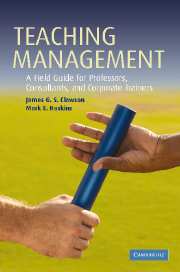Book contents
- Frontmatter
- Contents
- List of figures
- Sources to chapter quotations
- Why this book on teaching management?
- 1 Fundamental elements in teaching
- 2 Levels of learning: one, two, and three
- 3 Adult learning theory: it matters
- 4 Planning a course: trips and tips
- 5 Planning a class: no detail is too small
- 6 Lecturing: the possibilities and the perils
- 7 Managing discussions
- 8 Case method: fostering multidimensional learning
- 9 Role-playing
- 10 Case writing: crafting a vehicle of interest and impact
- 11 Case teaching notes: getting from here to there
- 12 Action learning
- 13 Experiential methods
- 14 Enhancing the conversation: audiovisual tools and techniques
- 15 Executive education: contributing to organizational competitive advantage
- 16 Using technology to teach management
- 17 Counseling students
- 18 Evaluating students: the twin tasks of certification and development
- 19 Teaching evaluations: feedback that can help and hurt
- 20 Research presentations
- 21 Managing a degree program: behind the ‘glory’
- 22 Managing a nondegree client program: an overview
- 23 Dealing with the press
- 24 Managing yourself and your time
- 25 Using teaching portfolios and course portfolios
- 26 Conclusion: is this on the exam?
- Index
25 - Using teaching portfolios and course portfolios
Published online by Cambridge University Press: 25 February 2010
- Frontmatter
- Contents
- List of figures
- Sources to chapter quotations
- Why this book on teaching management?
- 1 Fundamental elements in teaching
- 2 Levels of learning: one, two, and three
- 3 Adult learning theory: it matters
- 4 Planning a course: trips and tips
- 5 Planning a class: no detail is too small
- 6 Lecturing: the possibilities and the perils
- 7 Managing discussions
- 8 Case method: fostering multidimensional learning
- 9 Role-playing
- 10 Case writing: crafting a vehicle of interest and impact
- 11 Case teaching notes: getting from here to there
- 12 Action learning
- 13 Experiential methods
- 14 Enhancing the conversation: audiovisual tools and techniques
- 15 Executive education: contributing to organizational competitive advantage
- 16 Using technology to teach management
- 17 Counseling students
- 18 Evaluating students: the twin tasks of certification and development
- 19 Teaching evaluations: feedback that can help and hurt
- 20 Research presentations
- 21 Managing a degree program: behind the ‘glory’
- 22 Managing a nondegree client program: an overview
- 23 Dealing with the press
- 24 Managing yourself and your time
- 25 Using teaching portfolios and course portfolios
- 26 Conclusion: is this on the exam?
- Index
Summary
Of course, before we know he is a saint, there will have to be miracles.
– Graham GreeneProfessionals in fields such as art, photography, and architecture have long used portfolios to document and display their best work (Hutchings, 1998c, p. 13; Seldin, 2004, p. 3). Over the past fifteen years, portfolios have begun to be used more widely in higher education as tools for student, instructor, and institutional development. The portfolio can provide its audience with deeper and more meaningful evidence than simple description will normally allow, as on a résumé for example. In addition, the process of constructing the portfolio can lead to individual reflection and improvement.
This chapter describes teaching portfolios and course portfolios and provides guidance to individual instructors regarding their development and use. In addition to the individual benefits, teaching and course portfolios respond to calls for business schools and business instructors to take teaching more seriously and to develop the “teacher” role as fully as the “researcher” role (e.g., Frost and Fukami, 1997).
Teaching portfolios
A teaching portfolio is a collection of materials that document an individual's teaching performance, generally over a period of several years (Seldin, 2004, p. 3). It includes work samples and reflective commentary to reveal what was done and the thinking behind the teaching (Braskamp and Ory, 1994, p. 229). It is not an exhaustive compilation of all the documents and materials relevant to an individual's teaching performance; rather it presents thoughtfully chosen information on teaching activities along with “indisputable evidence” of their effectiveness (Seldin, 2004, p. 3).
- Type
- Chapter
- Information
- Teaching ManagementA Field Guide for Professors, Consultants, and Corporate Trainers, pp. 462 - 479Publisher: Cambridge University PressPrint publication year: 2006
- 1
- Cited by

